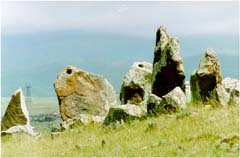 Another reason is that Herouni made a further calculation:
The calendar Herouni refers to is not a first calendar, it is
a calendar change.
Another reason is that Herouni made a further calculation:
The calendar Herouni refers to is not a first calendar, it is
a calendar change.
"I refer
to King Haik, who many think was a legend. By my studies,
and through archeological finds, his name appears in historical
chronicles of that time, looking very much to me like he was
an actual person."
Haik is
connected to the Babylonian King Nemruth (Nemrod), who is connected
in the bible with the tower of Babel. Armenian legend
calls Nemruth "Bel", but retains the story of Babel. In
that legend, Haik is supposed to have participated in the construction
of the tower, but when it fell he left Babylon, taking his people
to the North. Herouni points to a Babylonian clay tablet
where Nemruth wrote to Haik, asking him to return.
In the legend
Haik refuses, and Nemruth sent an army to punish him.
Haik's army, skilled archers, are said to have slain the army,
Haik's arrow piercing Nemruth's armor. Haik took Nemruth's
body to his capital near Lake Van, where he hung him from his
tower, a warning to anyone who doubted his own strength.
Nemruth's
death is mentioned on actual Babylonian border stones at the
site where the battle is said to have taken place. Those
stones and the clay tablet letter to Haik convinces Herouni
that the legendary Haik was in fact an historical person.
"And this
part is not legend. Haik changed the old Armenian calendar
to celebrate his victory, by changing the names of the months
to the names of his sons and daughters. He had ten children,
so two of the months kept their original names."
Unlike other
calendars, the Armenian calendar is a solar calendar.
While the Egyptian calendar is also based on 12 months and 30
days, the Armenian calendar includes 7 days in a week, and each
day of the month has its name.
"Egypt and
Babylon used a moon calendar first," Herouni says, referring
to studies on historical calendars by Benik Toumanian and Haik
Badalian. "Or some combination. The Jewish calendar is
a combination of sun and moon calendar, it is very complicated.
Armenia never had a moon calendar, they knew about solar positions,
eclipses. They came up with a 365 day calendar, that had
to be corrected every four years."
And so to
Herouni, the changing of the old to the "main style" calendar,
which occurred in 2492 BC, is a second key to the dating of
the site at Sissian. "They had a calendar already,
because Haik changed it. And he changed it at the time
Arktur was ascendant above Armenia."
"And so
I asked myself, 'how long does it take to create a calendar?
How long does it take to understand the concept of time, to
divide it into units? And then how long does it take to
go further, to understand latitude and longitude, to develop
navigation? The entire ancient world was navigating by
the time Arktur was ascendant—they already had calendars, they
understood longitude and latitude."
Herouni
calculates it would have taken many years--perhaps thousands--
to create the system necessary to begin a calendar and develop
the kind of astronomy the people at Sissian used to build the
telescopes. "And so, I chose the earlier star, Capella,
which was ascendant around 4200 BCE."
If true,
it indeed shatters most histories on the beginning of astronomy.
It also coincides with the earliest zodiac designs in Armenia,
which appeared at the beginning of the 4th millennium BC.
|